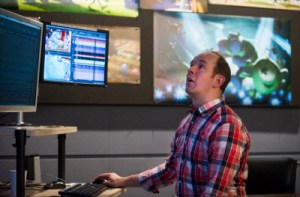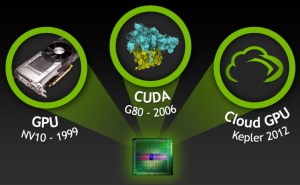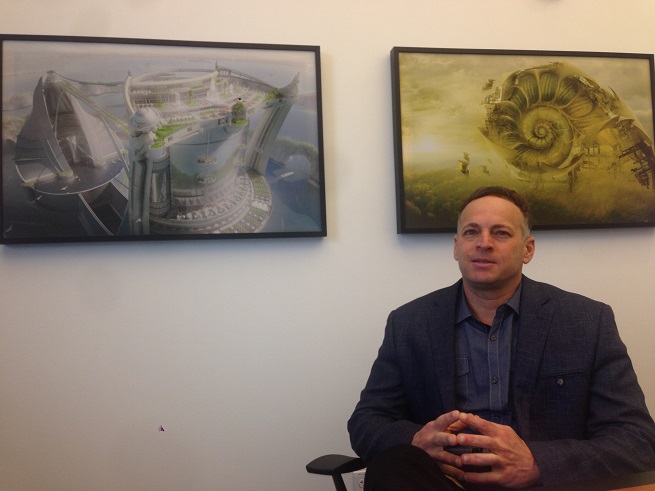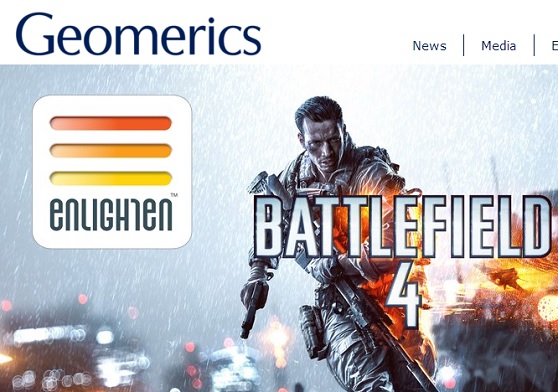VB: Cloud gaming has progressed. How would you describe the state of it right now? There was some early excitement around companies like OnLive. They ran into a wall, but they kept on going. Nvidia has also made some big investments in cloud technology.
Herbst: We’re investing heavily in the technology that allows cloud gaming to proceed. I’d say we’re in the rational phase of that business. You have a few companies that look to be building nice businesses based on that, and the initial overhype is gone. Now people are rolling up their sleeves and figuring out how to build businesses that make economic sense based on the technology. We’re seeing good traction.
We have G-cluster coming to present at the CEO On Stage portion of the event this year. Last year we had Playcast and Ubitus. We’ve spent a lot of time with these companies. We want them to be very successful. I think they will be. They’re on their way.
VB: Some of the challenge, the technological challenge there, is how to deliver gaming over the cloud efficiently, right? Without consuming too many resources in any one part of the system, like bandwidth.
Herbst: The technology’s now proven, I think. It’s a question of getting the business model to work. You do need to be as efficient as possible with your use of the hardware, because having a 1:1 relationship between the GPU and the user doesn’t work from an economic standpoint. But it’s clear to us that the technology works. There is enough bandwidth. We’ve seen successful deployments already.
The other piece of building a cloud gaming service is that you have to have the content. There are a few companies that have spent the time and the resources and the money to go out and get all the content together. It’s more of a question of the business model right now, as opposed to the technology, which is already there.
VB: What do you think of regional differences, and the opportunities for startups in different regions? Asia is starting to stand out in a lot of ways. If you look at M&A in the game business, nine out of 10 deals have Asian buyers.
Herbst: It probably makes sense in the game business. What we see in terms of startups that are using GPUs to build their business is that it’s a worldwide phenomenon. We see a lot of people in Israel doing things in high-performance computing and computer vision. We tend to see a lot of companies in Europe that do things around visualization. We see companies all over doing GPU-based businesses in finance and big data.
One of the interesting things about my job, and why I tend to travel so much internationally, is that this is a worldwide phenomenon. The majority of my business trips are outside of the U.S. A lot is going on here in Silicon Valley, but a lot’s going on in London, Tel Aviv, other parts of Europe. Like you say, gaming is happening a lot in Asia, but we tend not to see as many hardcore technology startups using our GPUs in those areas. I would love to see more. In fact, Asia, and China in particular, is an area that I want to target even more. That’s on my list of priorities for this year. If people can be helpful to us, we’re very open to that.
 VB: There’s this tool chain in the middle of things, making games or making movies more efficiently. There seem to be lots of opportunities there.
VB: There’s this tool chain in the middle of things, making games or making movies more efficiently. There seem to be lots of opportunities there.
Herbst: We’ve seen a lot of those businesses over the years – game engines, tools. NaturalMotion started off as a tools company before they became a content company. They were building tools for animation. Epic Games started out as a game engine and then moved toward first-party content as well. These are decent businesses, but I think middleware has traditionally been a tough place to build a big company. The most successful examples are some of the ones I mentioned, who’ve also done something else to exploit their middleware.
VB: As far as how much better this gets, with new generations of hardware, you have more room for power efficiency?
Herbst: Like I said, I travel around the world and talk to people about GPU computing, the use of GPUs in games and so forth. I continually get asked for more computing horsepower. When? How much? I don’t think we’re even close to saturation right now, especially with these new applications like computer vision and big data and analytics. We’re just scratching the surface. These are things that can consume an unlimited amount of compute horsepower.
It turns out that for these parallel-type tasks, a GPU is much more efficient than a CPU. Especially when you get into cloud applications and data centers. Heat and power are huge factors as well. Any improvement in efficiency improves the heat and power situation.
Again, Bitcoin mining is a good example. There’s a reason why people went crazy buying GPUs for Bitcoin mining. It’s a hard problem, and the problem gets harder every day. The algorithm that they have to solve gets more difficult. Having a programmable engine like a GPU that can do that very efficiently ends up allowing people to make money.
VB: Do you have any concern that the U.S. is behind in anything? I’ve voiced the feeling that mobile bandwidth is a ligature in the U.S., compared to other countries.
Herbst: I personally don’t feel that way. I can see how you might have that perception, given the amount of mobile gaming that goes on in places like Korea. But Korea and Asia have always been leaders in gaming, even on the desktop. You probably know this, but a good portion of Nvidia’s hardware sales end up in places like China and Asia. It’s a huge market for us. As is the U.S. and EMEA.
VB: So you see that kind of catching-up as something that’s always happened? Other countries may lead, but they don’t necessarily take over.
Herbst: If you look at how the mobile revolution started, Europe was ahead 15 years ago. Now I would say that the U.S. is one of the places you’d consider to be on the leading edge of mobile network rollouts.
VB: All these gaming platforms are multiplying still. The micro-consoles are out there trying to get traction, in the home and in general. Do you have any observations about that?
Herbst: It’s early days for those platforms. We’re big believers in the Android gaming ecosystem. Folks like Ouya—I can tell you, we have an investment in them. They’re leading the charge there. There are others as well. We’re supportive of all of these companies. The more companies that adopt the Android gaming ecosystem, the more opportunities there will be for Nvidia in the future.
VB: What themes do you see at the larger show?
Herbst: Clearly automotive is becoming a theme, and not only for the graphics aspect of the entertainment media displays, but also for the computer vision aspect of automotive. Taking the road data and the pictures and figuring out whether you’re going to hit anything, whether there’s a pedestrian, whether you should go out of your lane, that’s a big theme.
Big data, another big theme. Computer vision I’ve mentioned. Machine learning is big for us this year. And then all the visualization things that we’ve seen in the past, just getting better and better. Mobile and cloud of course.
What I tend to do is span across all of those different verticals, as you might call them. I’m looking for people doing early stage commercial-ready things in the areas that are interesting to not only Nvidia, but also the rest of the people who are attending GTC. That’s what the Emerging Companies Summit is. It’s been successful in the past, and I’m looking forward to a good one this time.
VB: Do you see anything interesting related to Tegra K1 deployments coming into the startup picture?
Herbst: It’s a little early to talk about that. We just recently announced it. The startup activity on a new product like that tends to take a bit longer to develop. Maybe next year we’d talk about that.
 VB: If you look back, there are always skeptics about whatever things you guys do. What do you remember most as far as what people have been skeptical about?
VB: If you look back, there are always skeptics about whatever things you guys do. What do you remember most as far as what people have been skeptical about?
Herbst: I don’t think people believed we would get this much traction in GPU computing and our Tesla business. We’ve surprised a lot of people. Not ourselves, by the way. We always knew where the potential was. We’re we’ll past the tipping point now. You’re going to see this go into a hyper-growth mode. We’ve reached more than critical mass.
CUDA (Nvidia’s programming language) has been taught in schools and universities for a long time. People have good development tools for CUDA. Everyone I talk to around the world, they ask me about CUDA and GPU computing. I see great startups doing things I never imagined people would do, like database acceleration.
The company I mentioned earlier Sqrean, is extremely interesting to me. They’re in the middle of Israel. I met these guys and they just knocked my socks off with what they were doing. I had no idea this was even going on.
There may have been skeptics in the past, but now, people know this is for real. I believe we have a big head of steam. We’re ahead of everyone else in the space.
VB: AMD’s talked a lot about the 64-bit ARM in servers and data centers. Intel has very skeptically said that they’re still waiting for this to happen, that the micro-servers are about one percent of the market. There seems to be some skepticism on that front, like there was about things like CUDA. Do you see these as inexorable forces, ARM in servers?
Herbst: I’m not sure. The jury’s still out. It’s not an area that we’re focused on, but I am watching it pretty carefully. The ARM server camp has a long way to go to get any meaningful penetration. They’re dealing with a very established, strong competitor. From what I’ve learned recently, some of the companies doing this are starting to pull back. That may not be public information, but I know for a fact that ARM and their investors pulled the plug on Calxeda, which was building one of these products.
Going back to the conference, we’ll have some great stuff in the exhibit hall. In total, we have around 40 companies attending ECS in one way or another. There will be some surprises. I’m looking forward to learning about some of the companies that I don’t know that well. A lot of these companies in the Early Stage Challenge are very new to us. They’re very young. We haven’t spent time with them.
VB: How wide a net goes out there? If you have 40 appearing, how many applied?
Herbst: Quite a few applied for the Early Stage Challenge. The companies that we bring in for the CEO On Stage in the exhibition hall, we specifically invite them ourselves, but the Early Stage Challenge, we selected 12 out of some tens of companies that applied. It wasn’t hundreds. As people know about this more and more, we expect to get more applications.
We’ll see how this goes. I like surprises myself. I’m excited about how it’s going to play out. I can’t tell you what’s going to happen.
VentureBeat's mission is to be a digital town square for technical decision-makers to gain knowledge about transformative enterprise technology and transact. Learn More




